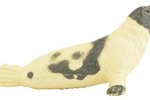
About 20 percent of the bottlenose dolphin's body weight is blubber, and with good reason -- this thick layer of fatty tissue serves several purposes, and some are more obvious than others. While the natural composition of blubber makes it easier for the dolphin to thrive in his natural environment, it also has chemicals that allow dolphins to heal more effectively and survive attacks from ocean predators more easily.
Keeping Warm
Though they are mammals, dolphins have very little hair -- they lose most of it before they reach maturity. This means that to stay warm in the ocean, they rely heavily on their blubber for insulation. Other marine mammals like whales and walruses also have thick layers of blubber under their skin for keeping warm -- without it, dolphins couldn't retain the body heat they need to survive in cooler waters.
Healing
The chemical makeup of dolphin blubber has restorative properties that help these creatures survive in a harsh environment. Dolphins may be preyed upon by predators like sharks, but their blubber actually helps them survive attacks more effectively. For example, blubber forms a protective layer over fresh wounds, which can then begin showing signs of healing within 24 hours. Blubber also has antimicrobial compounds in it, which can help prevent bite wounds from becoming infected.
Smoothing the Skin
Dolphins are sleek, aerodynamic creatures, and that's partially thanks to their blubber. While not all marine mammals can say the same -- walruses, for example, don't share the torpedo-like shape of these animals -- dolphins are naturally adapted for speedy swimming in cool waters. Their small limbs and compact bodies help them cut through the water, but blubber plays a large part, as well -- it smooths the skin into aerodynamic contours and gives them natural buoyancy.
Springing and Swimming
Blubber in dolphins isn't uniform from head to tail, and that enables these creatures to be more efficient swimmers. The blubber in dolphins' tails is relatively stiff, but the blubber around their midsections is about three times more flexible. This combination of elasticity and stiffness creates a springlike effect, so that dolphins can use their long, strong bodies to power the up-and-down paddling motion of their tails.
References
Photo Credits
-
Tom Brakefield/Stockbyte/Getty Images
Writer Bio
Tom Ryan is a freelance writer, editor and English tutor. He graduated from the University of Pittsburgh with a degree in English writing, and has also worked as an arts and entertainment reporter with "The Pitt News" and a public relations and advertising copywriter with the Carnegie Library of Pittsburgh.




